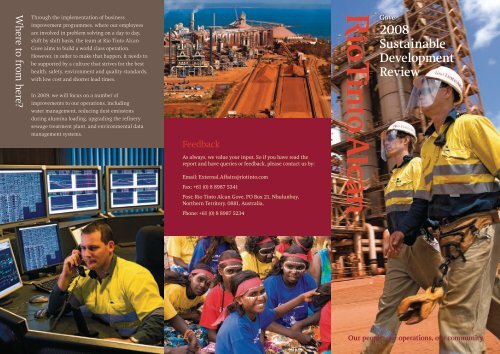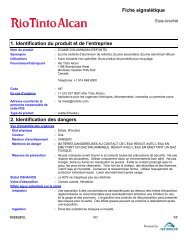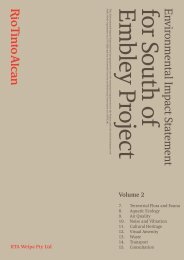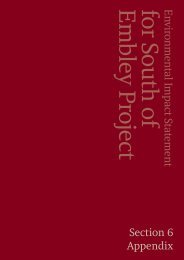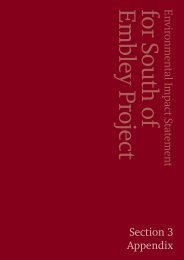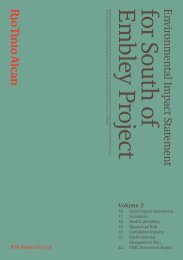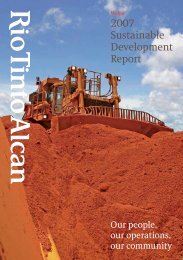2008 Sustainable Development Review - Rio Tinto Alcan
2008 Sustainable Development Review - Rio Tinto Alcan
2008 Sustainable Development Review - Rio Tinto Alcan
- No tags were found...
You also want an ePaper? Increase the reach of your titles
YUMPU automatically turns print PDFs into web optimized ePapers that Google loves.
B3 Come all you Farmers out of the CountreyNotes. This poem responds to James I’s July 1603 orders that all those worth £40 per yearshould present themselves to be knighted at his coronation. The orders prompted bitter commentsabout the debasement of the title. Sir Thomas Tresham, for instance, feared that some of those whoqualified for the title were “landless, many base and dosser headed [i.e. foolish] clowns, and notone among forty worthy of that degree” (qtd. in Stone, Crisis 75).“Verses upon the Order for making Knights of such Persons who had 40 pounds per annum in KingJames I. Time.”Come all you Farmers out of the Countrey,Carter, Plowmen, Hedgers & all;Tome, Dick, & Will, Raph, Roger & Humfrey,Leave of your Gestures rusticall.Bidd all your Home-sponne Russetts adue,And sute yourselves in Fashions new:Honour invits you to Delights:Come all to Court, & be made Knights.125He that hath fortie Pounds per Annum,Shalbe promoted from the Plowe:His Wife shall take the Wall of her Grannam:Honour is sould soe Dog-cheeap now.Though thow hast neither good Birth nor Breeding,If thow hast Money, thow art sure of speeding.310Knighthood in old Time was counted an Honour,Which the best Spiritts did not disdayne:But now it is us’d in soe base a manner,That it’s noe Creditt, but rather a Staine.Tush, it’s noe Matter what People doe say!The Name of a Knight a whole village will sway.2015
Maximising economic prosperityPeople Planet ProsperitysocialEnhancingMinimisingwellbeingenvironmentalfootprintArea 2007 <strong>2008</strong>Lost TimeInjuryFrequencyRate (LTIFR)*<strong>2008</strong>TargetTargetmet2009Target0.47 0.15 0.42 ✔ 0.27All InjuryFrequency 1.36 2.03 1.35 ✘ 1.56Rate (AIFR) #OccupationalIllnessTotalemployeesTotal femaleemployeesTotalIndigenousemployees(& contractors)**0 0 0 ✔ 1830 960125 11997 122NotargetNotargetNotargetN/AN/ANotargetNotargetN/A 140*A Lost Time Injury (LTI) occurs when a person is injured at work andcannot return to their normal duties on their next shift. A Lost TimeInjury Frequency Rate (LTIFR) converts LTIs into a figure that helpsto compare our performance with previous years and other <strong>Rio</strong> <strong>Tinto</strong>operations. The LTIFR averages out as the number of LTIs per 100 peopleworking on site, per year.#All Injuries (AIs) include LTIs and any injury that requires medicaltreatment. Like the LTIFR, we use the All Injury Frequency Rate (AIFR) toconvert the number of AIs into a figure that is easier to understand. TheAIFR represents the average number of AIs per 100 employeesper year.• We didn’t start the year well in safety. Our AIFR in the first quarter of<strong>2008</strong> was double our 2007 average.•Fifteen trainees, including four females, were recruited into the <strong>Rio</strong><strong>Tinto</strong> <strong>Alcan</strong> ALERT training programme. Trainees are prepared for theworkplace and gain confidence, experience and skills needed for dailyworking life.••In <strong>2008</strong>, we celebrated 40 years of working in partnership with localIndigenous owned business, Yirrkala Business Enterprises.The Discover DNA mentoring programme brought four students fromfour Australian universities to our operations to learn about the waywe work.• Seven new buses, with seat belts, were deployed on site. Not only are thebuses safer, there has been a noticeable dust and noise reduction, andincreased number of employees using them to travel to and from work.• Sixty office employees benefited from ergonomic assessments, such asbasic training in lifting techniques. The consultants who conductedthe assessments also completed site ergonomic hazard assessments andmade risk control recommendations.• A consultant from the Royal Darwin Hospital’s burns unit trained 150employees on burns awareness, focusing on the prevention of andresponse to chemical burns.• More than 600 employees, contractors and their spouses volunteeredto be vaccinated against influenza, free of charge, for the thirdsuccessive year.• We ran a hearing evaluation programme, which provided regularhearing tests for our employees with more than 460 audiometric testsadministered throughout the year.• In <strong>2008</strong>, 143 employees underwent voluntary medicals to identify anycurrent or potential medical conditions. Our occupational physicianprovided guidance for any conditions identified.• Stopping smoking has major and immediate health benefits.Employees who smoke and want to quit received support from the QUITsmoking programme in <strong>2008</strong>.• Seven ALERT trainees were the first in the Northern Territory tocomplete Certificate I in Resources and Infrastructure Operations.• We worked with the Australian Government and BP to help reducepetrol sniffing in East Arnhem Land communities by providingsafe, environmentally friendly storage for opal fuel. <strong>Rio</strong> <strong>Tinto</strong> <strong>Alcan</strong>discontinued its supply of unleaded fuel to the service stations in EastArnhem Land.• Confined spaces identification within the refinery continued in <strong>2008</strong>,with permanent hazard signage erected near all access points.• Minimising risks and identifying fall hazards are part of our everydayactivities. However, a comprehensive survey in <strong>2008</strong> identified criticalrisk situations and an inventory of anchorage points. We will use thesesurvey results to address and mitigate key risks in 2009.• Our health, safety and environment management systems were audited,with satisfactory results. No system failures were identified, but areas forimprovement were identified.Indigenous training programmeArnhem Learning Education Regional Training or ALERT is anIndigenous training programme designed to improve career pathwaysfor Indigenous trainees in the East Arnhem area. The programme,now in its second year, was developedin partnership with Charles DarwinUniversity and has an emphasis onaccelerated literacy.Throughout the programme, traineesreceive practical and relevanttraining, giving them greater accessto continuing work opportunities. Theprogramme supports each individualwith a specific learning plan to helpthem move into the career pathwayof their choice. Courses are nationallyaccredited and offer training inareas where there are long term andpermanent local jobs.Area 2007 <strong>2008</strong>Greenhouse gasemission intensity(tonnes of carbondioxide equivalentper tonne of aluminaproduced)Energy intensity(gigajoules per tonneof alumina produced)Freshwater used(tonnes per tonne ofalumina produced)Total waterextraction (includessupply to town andothers) (megalitres)Environmentalincidents – seriousconsequences(Category 3 andabove)Total mine landrehabilitation(hectares)Total mine landdisturbance(hectares)<strong>2008</strong>TargetTargetmet2009Target0.94 0.92 0.831 ✘ 0.38710.82 10.78 10.1 ✘ 10.04.67 4.27 3.31 ✘ 2.999,111 10,464 n/a* ✘ 10,30013 8 6 ✘ 471 158 141 ✔ 100360 257 200 ✘ Nil• We reduced our waste in <strong>2008</strong> through effective segregation andrecycling programmes that included colour coded wheelie bins andskip bins.•Even though the number of environmental incidents with a seriousconsequence rating was less than 2007, there were still eightenvironmental incidents with a serious consequence rating in <strong>2008</strong>.• Environmental monitoring programmes for marine sediments andwaters, surface waters, groundwater and air were maintained wellbeyond minimum compliance requirements.• Routine monitoring by our marine health monitoring programmeshowed, beyond our localised impacted areas, very good water andsediment quality was maintained in Melville Bay. Water quality waswithin national guidelines where guidelines were available.• Our total water extraction exceeded our licensed amount by 0.16 percent. Our water used per tonne of alumina produced was also higherthan our target.• The marine health monitoring programme team continued liaisingwith the Yolngu people by inviting the Dhimurru Sea Rangers toparticipate in seasonal seawater and seafloor sampling, and developingcommunication cards about the findings of the programme.• Our operations sometimes generate dust, which could potentially bean issue for our neighbours and the environment. To help monitor andmitigate dust generation, two more monitoring stations were installed in<strong>2008</strong> at Yirrkala and near Galupa.• Rehabilitating the land we use for mining is part of what we do. In <strong>2008</strong>,we planted over 12 hectares of pond wall faces with vetiver grass to helpanchor the topsoil and 187 hectares of mined land was rehabilitated andseeded with native species.• In <strong>2008</strong>, waste water from the water treatment plant at the steam powerstation was redirected, with multiple benefits including a reducedamount of waste water sent to the residue disposal area.• The drum yard was reorganised to help make the disposal of used oil,grease drums, and hazardous chemicals easier and more efficient.• Our energy consumption per tonne of alumina produced was higherthan our <strong>2008</strong> target.Recycled for road baseA small amount of the limestone we import to use in the refinery’s limeplant is not able to be used as it is too small. The reject limestone isstockpiled at the refinery and mixed with laterite to produce a gravelsubstitute used for road base and other projects.Used oil from the communitiesIn <strong>2008</strong> 350 tonnes of waste oil from the mine, town and communitieswas collected through the Nhulunbuy Corporation and combinedwith waste oil from the refinery. The waste oil – a valuable and finiteresource – is blended with the fuel oil supply for the calcination area ofthe plant where it is burnt to recover its energy content.Area 2007 <strong>2008</strong> IncreaseRefineryproduction(alumina ‘000tonnes)Mine production(bauxite ‘000tonnes)Employmentcontributions($m)Taxes androyalties ($m)1,885 2,325 4404,660 6,245 1,585136 154 1817 24 7• Much of <strong>Rio</strong> <strong>Tinto</strong> <strong>Alcan</strong>’s accommodation in Nhulunbuy has not beenimproved for the last 30 years. Recognising this was a major factor inattracting and retaining employees, significant progress was made by thehousing improvement programme to provide outdoor areas, carports andmany other upgrades to modernise the accommodation.•In <strong>2008</strong>, the Yothu Yindi Foundation, in partnership with <strong>Rio</strong> <strong>Tinto</strong><strong>Alcan</strong>, celebrated the tenth annual Garma Festival. The festivalcontinues to generate greater understanding between Indigenous andnon Indigenous Australians.• In <strong>2008</strong>, our business operations recommenced exporting bauxite aftera two year period. As a result, a small volume of high grade ore has beenextracted for future shipment to overseas customers.• We partnered with Telstra and the Northern Territory Government ona $20 million fibre optic project that will see East Arnhem Land homesand businesses benefit from faster internet connection.• Two buses were donated to a local Indigenous community organisationto enable them to set up a public transport schedule between localIndigenous communities. This will provide a cheaper transportoption for local people and assist outlying communities with access toemployment and health services.• In <strong>2008</strong>, 12 business improvement projects focused on watermanagement, energy reduction and increased productivity werecompleted.• During <strong>2008</strong>, opportunities to reduce costs and increase the utilisationof the truck mining fleet were identified. One initiative involvedsuccessfully trialling the use of part time employees and ALERT traineesto operate 100 tonne haul trucks during meal breaks.• We worked to improve the capability of our shiploader, which will helpus export an additional 200,000 tonnes of bauxite in 2009.Miwatj Leadership <strong>Development</strong>Programme (MLDP)The MLDP was developed in partnership with the <strong>Rio</strong> <strong>Tinto</strong> AboriginalFoundation, <strong>Rio</strong> <strong>Tinto</strong> <strong>Alcan</strong> Gove, Aurora Project, Australian GraduateSchool of Management, and the Australian and Northern TerritoryGovernments. The programme was designed to develop the nextgeneration of Indigenous leaders in the region. The goal is to maximisepositive outcomes for all Indigenous people in the region throughprosperous new business aligned with the natural resources industryand opportunities.One participant commented: “I’d honestly have to say that the wholeprogramme far exceeded anything I’ve previously done. Well doneto all concerned, a great concept to bring to Arnhem Land, andcongratulations to everyone involved. This programme has given a lotof confidence to those who attended.“Overburden removal innovationIn <strong>2008</strong>, we introduced a new technique for removing the overburdenlayer before mining the ore body. Hidden surface irregularities and deepchannels filled with high silica and organic material were uncoveredby the excavator, resulting in significant operational costs. Using thisnew technique, currently in the testing phase, could save more than$23 million for the refinery over the life of the mine, in addition toproviding benefits to the environment.Super teaching clinic for doctorsIn <strong>2008</strong>, we started a partnership with the Northern Territory RuralClinical School, Adelaide’s Flinders University, Northern TerritoryGovernment and Charles Darwin University to develop a super teachingclinic for doctors.The facility will provide academic and education resources for a widerange of students and trainees across the East Arnhem region. It willalso support the development and delivery of orientation, patienteducation and language resources.The aim is to address the community’s healthcare needs by providingmultidisciplinary education that emphasises patient centred care. Thiswill help ensure patient outcomes improve and the workforce is bettertrained. We are looking forward to further developments in 2009 as thispartnership progresses.


